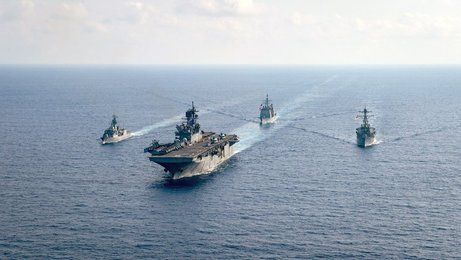Chinese Discourse on NATO

Analysts from institutes closely connected to the Chinese authorities constitute the majority of the ongoing expert debate in China on NATO. The reasons for this rise in interest include the internal Alliance discussion since last year about China, the tensions caused by U.S. pressure on members to acknowledge China as a threat, and the statement by French President Emanuel Macron about NATO’s “brain death”. The discourse in China is dominated by the current role of the Alliance and its threat perceptions, as well as the internal NATO divisions and discussions about China.
Chinese Perception of NATO
The Chinese experts usually start their analyses with a brief historical outline to emphasize that during the Cold War, the Alliance’s main adversary was the Warsaw Pact. The collapse of the bipolar system thus lead to questions about NATO’s purpose. In these experts’ opinion, after the Cold War, NATO began to look for a new adversary to justify its existence. At the same time, it began to transform from a military alliance into a political one with global ambitions. As a result, it shifted interest from collective defence to crisis management, which led to actions outside the territory of its member states.
According to the Chinese experts, the U.S. treats NATO instrumentally. Since the end of the Cold War, the U.S. has designated the enemies of the alliance and the member states have followed the Americans. The top enemies have become not only Russia (a view strengthened since 2014, after, as the Chinese describe it, Russia’s inclusion of Crimea and the beginning of the Ukrainian crisis) but also terrorism, prompted by the attacks on September 11, 2001. The resulting global war on terror prompted the Alliance to expand its mandate and act outside member state territory, leading it to interfere in the internal affairs of other countries, such as Afghanistan, Iraq, Libya, and Syria, or against the so-called Islamic State (ISIS).
The Chinese experts then focus on the growth of internal divisions and on contentious issues in the Alliance. In their opinion, one dividing line is NATO’s attitude to Russia, described as a gap between “old” and “new” members. Central Europe, including Poland, is seen as the most afraid of Russia, with evidence including the efforts of the Polish authorities to increase the number of U.S. troops in the country. Meanwhile, the “old” members are willing to cooperate with Russia, as evidenced by Macron’s statement favourable to Russia or Germany’s cooperation with Russia in the construction of Nord Stream 2.
Another area of division is the increased U.S. pressure on NATO members to bear more costs. Despite the goal announced at the 2014 Wales summit that by 2024, Alliance countries will spend at least 2% of their GDP on defence, the Chinese experts claim not all NATO members see the need for a significant increase in spending, believing that Russia and China do not pose a serious threat to NATO. This indicates another dividing line—the lack of consensus on actual threats to the Alliance.
The thesis about an alliance in crisis is strengthened by Macron’s statement that NATO is experiencing “brain death”. As the Chinese analysts point out, this stems from the reduced U.S. interest in the Alliance and pushes politicians in some member states into declaring their willingness to cooperate with Russia. However, the Chinese experts also leave out the part of Macron’s statement in which he mentions the possibility that Russia will distance itself from China. Many of them highlight U.S. President Donald Trump’s statements claiming NATO is “obsolete” and cite U.S. unilateral actions, such as withdrawing troops from Syria without informing the Alliance. As a result, the experts expect the divisions within NATO to deepen, citing the calls in Europe to strengthen the continent’s defences.
Friction also is seen between the U.S., European countries, and Turkey. According to the Chinese analysts, Turkey’s importance to NATO is decreasing compared to the Cold War period. The reasons are the internal political changes in Turkey, differences in the assessment of the situation in Syria and on ISIS, and Turkey’s rapprochement with Russia, including the purchase of an S-400 system. Turkey broke confidence in the Alliance when it entered northern Syria without proper notice. Other divisions between the U.S. and European NATO members concern Iran and the nuclear agreement.
Assessment of NATO’s China Debate
The Chinese analysts argue that the Alliance’s discussion about China represents a crisis in an organisation looking for a new enemy. The choice of China would harmonise with President Trump’s anti-China policy and serve as an attempt to overcome NATO’s identity crisis. For now, the Chinese experts do not see any threat to China from the Alliance despite the ongoing debate about the PRC. The NATO meeting in London in December 2019 and the adoption of a joint declaration that explicitly mentioned China for the first time are assessed more as a nod by the European members to the U.S. than de facto recognition of China as a threat. Again, the analysts view the statement as proof of the internal divisions and opposition of European states to the U.S.—despite the pressure from the Americans, China was not explicitly described as a “threat”, but as an opportunity and a challenge.
The experts are pleased to note the lack of unity in the Alliance when it comes to assessing China. They point out the positions of France or Germany, which do not list China as a serious threat. In the French case, the Chinese analysts highlight, for example, the good atmosphere and results of Macron’s visit to China in November last year. They emphasize that while European countries have disputes with China, they are related primarily to economic cooperation, not security. Other evidence of differences in the Alliance include selected statements by Secretary General Jens Stoltenberg, who tends to soften NATO messaging regarding China. They cite his assurances that the Alliance does not see China as its new enemy and is unlikely to be involved in the South China Sea, where China has territorial disputes with several countries from the region.
Conclusions
The Chinese expert analysis indicates that the Alliance is becoming another dimension of the rivalry between the U.S. and China, demonstrated by the conciliatory position of the latter towards European Alliance members and their criticism of U.S. actions. This approach is similar to China’s EU policy, which is not about dividing or breaking up the Union, rather maintaining a community of views at a level acceptable to the Chinese authorities—perceiving China as a partner, at least on selected issues. The aim is to prevent the development and subsequent implementation of a decidedly anti-Chinese course.
The continuation of the NATO debate on China may lead the latter to support European members that do not share the American position in order to prevent a consensus on naming China as a threat to the Alliance. This may take the form of persuasion that a state remain neutral in U.S.-China disputes or even to bet on China. This may include Chinese economic concessions or offers to cooperate with NATO on issues in which European countries have different opinions from the U.S., such as the Iran nuclear deal (JCPOA). China may also emphasize its support for strengthening the EU’s Common Security and Defence Policy and the idea of EU strategic autonomy. This is suggested by the positive opinions of the Chinese analysts about France’s ideas for Europe to be more autonomous and less dependent on the U.S. Similar voices appeared after reports that the U.S. will withdraw some of its troops from Germany. Such an approach would be in line with the Chinese assumption in which Europe is a potential partner of China in competing with the U.S. when Europe breaks with the U.S. in various areas.
Because there is a lack of consensus on China in the Alliance, the Chinese do not fear the debate. However, the experts recommend the Chinese authorities prepare for a tighter approach by NATO and react actively and flexibly. Although no specific recommendations are offered, one response might be to strengthen Chinese-Russian cooperation. This possibility is demonstrated by Chinese leaders’ confrontational statements about the U.S. during the Chinese parliamentary session in May, positive approach towards the EU and its member states, and affirmative stance on Russia. This was also indicated in a statement by the Chinese foreign minister, who pointed out that Russia-China relations are the best they’ve been in a while among the powers and that both countries will not allow their strategic cooperation to be broken.


